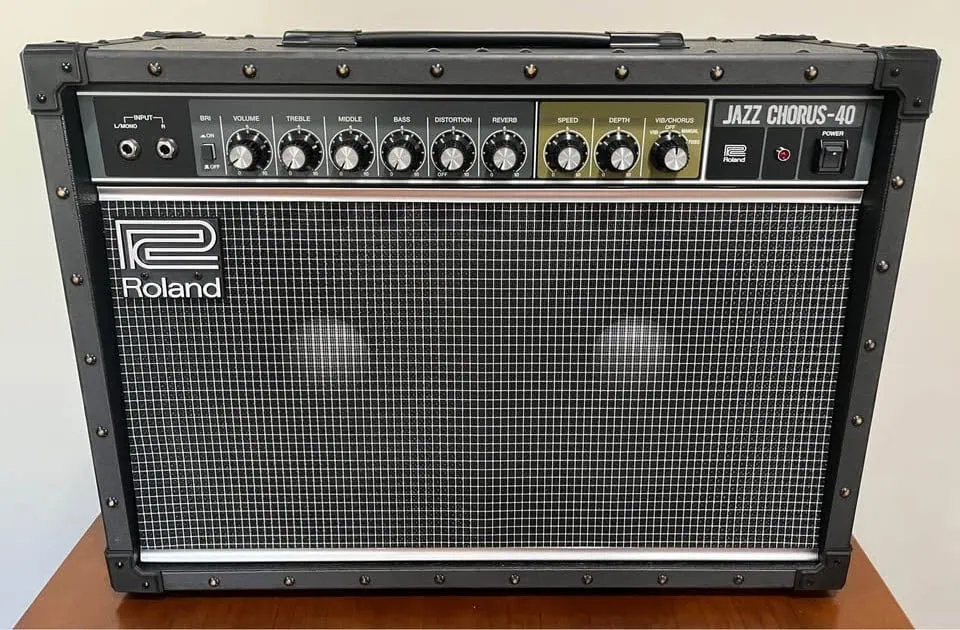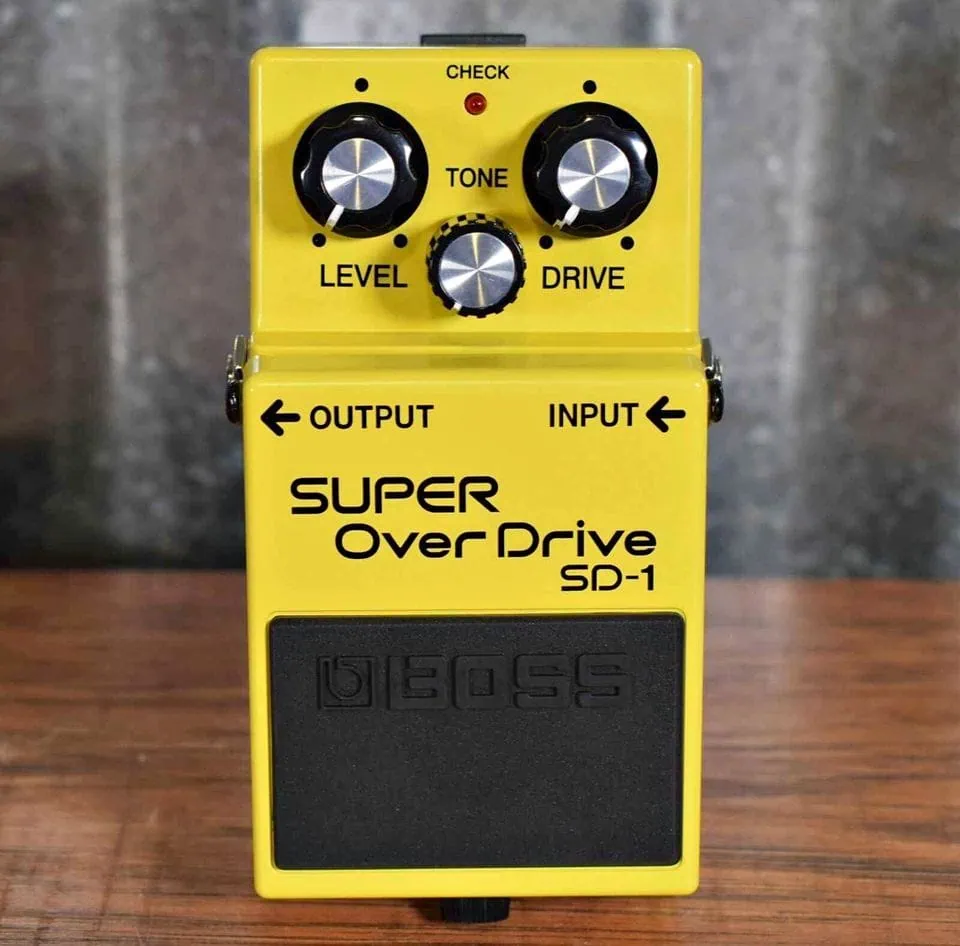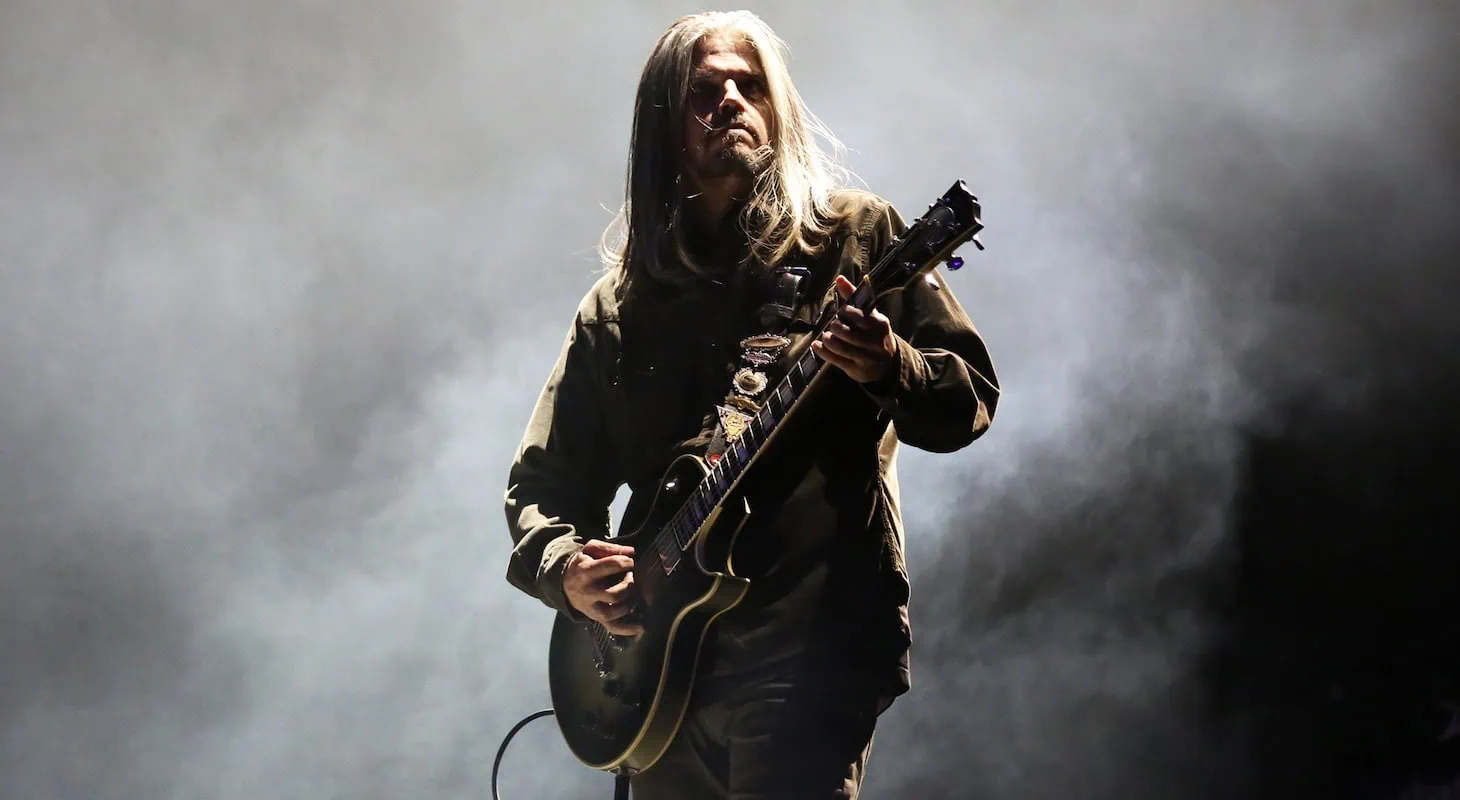To say that Tool is one of the most creative, mercurial bands in heavy metal music would be an understatement. I still remember hearing their album 10,000 Days at a friend’s house way back in high school. We were both into music, and among our peers we were some of the best players.
We just sat on his couch in awe, knowing there was no way we were going to get up and play anything close to what we were hearing.
This is due in no small part to the unique, immediately identifiable approach of their guitarist, Adam Jones. Jones’ style is hard to pin down: he bounces from one family of techniques and tones to another effortlessly, as Tool’s music demands. He is one of the most creative guitarists in music.
Any Tool fan will tell you that most of Adam Jones’ sound comes from his technique. How he plays is more important than what he’s playing. From his complex rhythms, riffs, and melodies, to his equally complex sound, this rings true.
What exactly goes into creating his guitar sound, and can we recreate it without breaking the bank?
I’ll never claim to be half the player Adam Jones is, but I’ve spent enough of my life around guitars to know a thing or two about generating tones. I took it upon myself to take a look at Adam Jones’ guitars, amps, and pedals, and see how we can go about recreating his unique sound.
Table of Contents
Guitars

This one’s easy: like me, and most of my guitar heroes, Adam Jones is a Les Paul guy.
Adam Jones has only ever used one guitar throughout his career, a Gibson Les Paul Custom Silverburst. I didn’t fully clock this until I saw Tool live at a festival back in 2011: he created all the lush, punishing soundscapes of Tool’s music with one guitar.
It was also the first time I ever saw a Les Paul in that color. The silverburst finish is a rare one, and Jones’ 1979 model has a few major differences that affect its tone.
Late ’70s Les Pauls were built a little differently from earlier models. His features the infamous “pancake” body, rather than a slab of mahogany capped with a slab of maple. Many Les Pauls of the era also featured a maple neck, but Jones’ appears to be the standard mahogany neck.
Fortunately for dedicated Tool fans, his actual Les Paul was recreated in painstaking detail by the maestros at Gibson.
The Adam Jones signature model is built to Les Paul Standard, rather than Custom, specs, but it’s a great start. It features Gibson’s own high-gain variation on the Burstbucker in the neck and an even hotter pickup in the bridge: even if you aren’t playing Tool, it’s perfect for heavy metal.
Fortunately for those of us without arena-headlining budgets, there’s an Epiphone version too, with specs closer to that of a Les Paul Custom. The Epi version also has an ebony fretboard, which is nice and hard for articulating Jones-style 3-string pull offs.
The bridge pickup in the Epiphone is a Seymour Duncan Distortion, so it sounds closer to Adam Jones’ actual tone than a stock Epiphone pickup would.
Beyond these two guitars, any modern Les Paul Custom would work just fine to recreate the Tool sound.
That doesn’t mean that you can only recreate Jones’ sound with a Les Paul Custom. A standard Gibson Les Paul will work just as well. Also, you can always go for an Epiphone Les Paul on a tighter budget.
I would, if picking up a different Gibson or Epiphone Les Paul, look at changing out the pickups, and trying to get one with an ebony fretboard if possible.
The fretboard won’t change much about the guitar’s tone at the higher gain levels necessary for playing Tool songs, but it will encourage technique choices closer to those Adam Jones would make.
For the pickups, it’s easy to get a hold of Duncan Distortions and put them into an Epiphone (or underpowered Gibson) Les Paul.
Jones has also reportedly used a Gibson SG for some studio work. Although, there aren’t any specifics about the SG that he used.
Amps
Having seen Tool live, I can attest that Adam Jones runs three amps on stage. These are a Mesa, a Plexi, and a Diezel. They’re on at different times, and sometimes more than one is on at once.
For his high-octane distortion sound, Adam Jones uses his Diezel VH4. This amp can do everything needed in terms of distortion and clean for recreating Jones’ sound.
As a general rule, he also runs a Mesa Boogie and a high-wattage Marshall Plexi. Neither of these is cheap, nor are they quiet.
I’m a big fan of the Marshall SV20H for Plexi tones. A Mesa/Boogie Dual Rectifier and Rivera Knucklehead have also made appearances over the years.
Often, especially for studio clean tone, Jones uses a Roland Jazz Chorus. These are all over the place: it’s a fairly common amp used by many guitarists. It has a great bright tone and pairs great with pedals.

One of the most interesting aspects of Jones’ amp rig is the Roland Cube 15 that he uses. A very low-powered amp that you wouldn’t usually find in a professional setup. According to Jones, however, the Cube 15 is perfect for his talkbox effect.
The amp heads are paired with Mesa/Boogie cabinets. Jones actually uses both a 4X12 Rectifier cabinet and a 2X15 Bass Cabinet. The bass cabinet is used to give his guitar sound more low end and power since he is the only guitarist in Tool.
I strongly recommend the Mesa Mini Rectifier and the VH Micro as alternatives to their full-wattage elder brothers.
Of the three quintessential Adam Jones amplifiers, most guitar players are only going to run one. My choice would be the Mesa Rectifier: it’s going to cover the most ground tonally, plus there’s the option to simply use the Diezel preamp as an extra gain stage.
Pedals
Adam Jones’ list of pedals is quite extensive. He uses a variety of Boss and MXR pedals, a few Dunlops, Rolands, and a number of others.
The key effects to get started with Adam Jones’ tone are:
- Overdrive/distortion. If I’m just using a Mesa or a Marshall, the VH4 pedal works great here.
- EQ set to a slight top boost for clear, chiming highs. I’m partial to the Boss GE-7.
- Delay, mostly set around 500ms. For “Pneuma” and its classic delay-laden riff, I set it to a single repeat. An MXR Carbon Copy or Boss Digital Delay are awesome for this.
- Flanger, set relatively slow. The chilly, metallic tone of the Boss Flanger is perfect for this.
- Wah, used when you can hear a wah. A Dunlop Cry Baby is my wah of choice.
- Noise gate, always on, to tame feedback and unwanted noise. I recommend the Boss Noise Suppressor.
A volume pedal and compressor are very useful here, too. Adam Jones tends to layer his guitar parts in the studio meticulously. Tool’s albums benefit from a solid amount of in-studio compression, so adding a compressor to the guitar signal is a reliable way to replicate this sound.
For Tool playing, I keep the EQ, reverb (if the amp has it) and compressor always on, and turn the extra layer of dirt on for heavier choruses, especially on songs like “Stinkfist” and “Eulogy.” Kicking on the VH4 preamp/drive works great here.
What often sounds like higher levels of saturation in Tool’s music is actually studio layering and the presence of Justin Chancellor’s spectrum-filling bass. Adam Jones uses much less preamp fizz than I initially realized.
If a talkbox is also wanted, the TC-Helicon Talkbox will work fine. The Dunlop HT1 that Jones uses is a bit of a rarity these days.
For cleaner guitar parts, I roll back the volume knob on my Les Paul.
Adam Jones Amp Settings
Because Jones uses multiple amps and blends their sounds quite often, you won’t be able to recreate his sound exactly with just one amp. Luckily, you can still get quite close with the right settings.
The most important thing to remember about his tone is that it has quite a lot of low end and midrange, and less distortion than you might expect. The easiest way to recreate his tone is by turning all the amp settings halfway, then slowly dialing up the bass, mids, and gain. Then dial back the treble until it sounds right.
For nailing the tones from “Parabol” and “Lateralus,” your settings should look something like this. Add appropriate seasoning from the pedals outlined above.
- Bass – 7/8
- Mids – 7/8
- Treble – 3/4
- Gain – 6
- Volume – 6/7
However, there are some more specific settings for some of the amps that he uses to work with.
His Diezel VH4, for example, has the treble and mids set a bit higher. The gain and volume are kept at half.
The Diezel also makes use of both Channel 3 and the Master settings. These apply to the VH4 pedal as well, conveniently.
For Channel 3:
- Bass – 8/9
- Mids – 9/10
- Treble – 8
- Gain – 5
- Volume – 5
For Master:
- Volume – 5
- Mix – 1
- Presence – 5
- Deep – 7
On something like a Marshall amp, the gain is turned up quite a bit, with the volume turned up slightly. The EQ stays the same, with perhaps the mids being rolled back a little bit.
Adam Jones’ Plexi (really, a vintage Super Bass) lacks a master volume and an independent gain knob.
With Marshall amps, I find it’s best to turn up the volume until the poweramp starts to hit saturation, and EQ from there.
On a Marshall with a discrete gain knob, I’d recommend turning up the gain until just before notes become mushy. Marshall amps are notoriously fickle when it comes to gain, so adjust according to taste: if you’re using the VH4 preamp/drive in the signal chain, you won’t need as much amp gain.
For Marshall:
- Bass – 8/9
- Mids – 8/9
- Treble – 8
- Gain – 8
- Volume – 6/7
If you are using pedal distortion instead of amp distortion, use a modern pedal with a lot of saturation. Something like the Boss ST-2 will work great.
Other Tips
Jones’ tone is fairly tight and controlled. Using a compressor, like the MXR Dyna Comp, will help to rein in the sound. A noise gate can also be useful for controlling the sound a bit more, like the MXR M195.
To help compensate for the lack of amps and to help shape your tone a bit more accurately, use an EQ pedal. The MXR M108S is a great ten-band EQ that isn’t too expansive.
Adam Jones almost always has a slight bit of reverb on top of his sound. Use a reverb pedal with just enough reverb to make your sound a bit more vibrant. I like the MXR Reverb.
He also almost always boosts his sound during choruses and heavier sections of songs. This is usually done with an overdrive pedal like the Boss SD-1 or the Boss DS-1. But any good, modern overdrive pedal should work just fine.

Most of Adam Jones’ recorded tone comes from layering guitar parts and his distinctive technique. This is very important. Even with all the right gear, I have to pay very close attention to how he’s playing to get even close to his sound.
Take note of where he applies vibrato, which notes are bends, slides, or hammer-ons, and get to grips with his hitherto unreplicated multi-string-pull-off technique (see the video below). This technique is as important to his sound as alternate picking and tapping is to Van Halen’s: it’s an irreplaceable part of the tone.
Anyone trying to play Tool without Adam Jones’ technique and phrasing might as well play it on a banjo. It’s that important to the sound!
Final Thoughts
Tool has one of the most complex sounds in music. It comes at no surprise then that their guitarist, Adam Jones, would have an equally complex gear setup.
Blending multiple amps and many effects pedals, it can be easy to think that his sound can’t be recreated. Fortunately, even with one amp and the right set of pedals, anyone can get pretty close to Jones’ unique sound.
All you need is a Les Paul, a Mesa (or Diezel, or Marshall), and a few key pedals to get started mastering some of the most demanding riffs ever crafted. Enjoy!


Hi,
Thanks for the article. I read it with big interest. 🙂 I found another article at Reddit, that talks about the tone knob. It says make it 15-20%. That makes a darker, rounder sound.
Did you consider the tone knob adjustments for you amp EQ suggestions?
Do you know the tone knob adjustments Adam uses?
Thanks in advance,
Matthias